The Irish doodle is a crossbreed dog mix that was created by mating a female Irish setter with a male poodle. Combining the best traits of both dog breeds, the Irish doodle is a special and often sought-after breed.
Below, we’ll outline this crossbreed’s appearance, temperament, personality, and care and training requirements.
TABLE OF CONTENTS
What is an Irish Doodle?
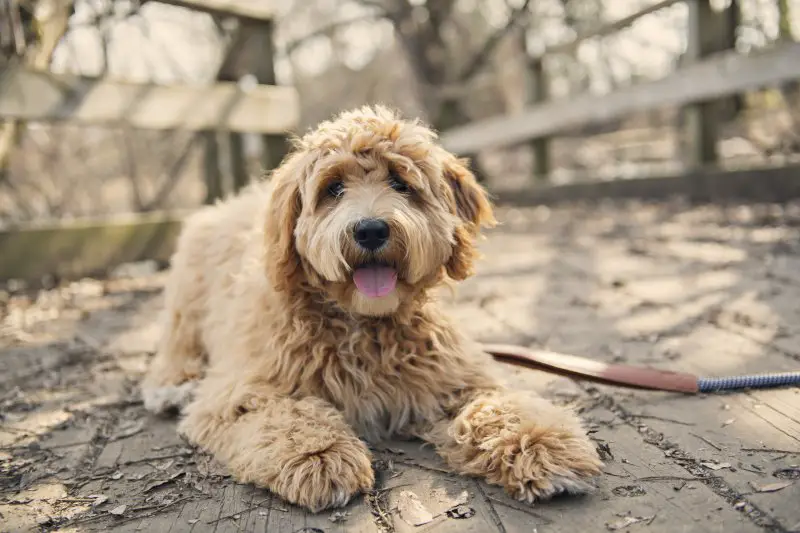
If you have never heard of an Irish Doodle, don’t feel too bad, because this dog has only been around for the last 30 years. Not only that, the Irish Doodle is not recognized as an actual breed by the American Kennel Club (or any other reputable Kennel Club) – which only includes purebred dogs in its registry.
So what exactly is an Irish Doodle? This is a mixed breed dog that was created by mating a female Irish Setter with a male poodle. Now, some people might call the puppies born as a result of such a match “mutts”. But people in the know about dogs and dog breeding prefer to categorize this dog as a “designer dog breed” or a “hybrid”. Irish Doodles are not born due to a breeder being careless or irresponsible when his Irish Setter is in heat. Irish Doodles litters are carefully planned for and raised with care for eventual sale.
Irish Doodles are smart, active, friendly dogs. On top of having wonderful personalities, they also happen to be quite adorable. With soft, wavy fur and brown button eyes, they resemble cuddly teddy bears. Also known as Irish Poo Setters, Irish Setterpoos, and Irish Doodle Setters, this crossbreed is rapidly becoming more popular. Today, Irish Doodles are so sought after that this “mutt” can cost more than either of its purebred parents.
To get a better understanding of an Irish Doodle’s traits, the best source of information are its parents. Poodles have three common sizes: toy, miniature, and standard. Only standard and miniature poodles are bred with Irish Setters. But when miniature poodles father the litters, the puppies born are called Mini Irish Doodles.
The Poodle originated in Germany, where it was called a Pudlehund. “Pudle” translates into splash about, and “hund” is dogs. The Poodle was bred to retrieve waterfowl for hunters, like Labrador and Golden Retrievers, and have been bred and raised in Europe for centuries. Poodles are the second most intelligent breed in the world, after the Border Collie. So any “Doodle” dog is guaranteed to be a smart one.
Irish Setters were developed in Ireland as a field hunting dog in the 1700s. They were bred to search for birds and then remain in a position to protect themselves from moving into the line of a hunter’s fire. In the mid-1800s Irish Setters were imported to the US as gun dogs and retrievers of game birds, and in 1878 were recognized by the American Kennel Club.
Almost all the Irish Doodles in the world today are F1 dogs, which means the first generation. When the parents of an Irish Doodle are a purebred poodle and a purebred Irish Setter, the litters are healthier, but what each puppy will look like is somewhat unpredictable. Irish Doodle puppies can look like a wonderful combination of the two breeds they descend from, or they might look more like one than the other. Since the “breed” cannot easily be standardized, it has never been recognized as an official breed.
Recently, breeders have been experimenting with breeding F1 Irish Doodles to non-related Poodles. The resulting litters are 75% poodle, and 25% Irish Setter, and have more hyper-allergenic coats than the 50-50 Irish Doodles.
Regardless of what they look like, Irish Doodles are bred as companion dogs. They are even-tempered, lovable, and affectionate. Irish Doodles are recognized by the International Designer Canine Registry (IDCR), the Dog Registry of America, Inc, (DRA), and the American Canine Hybrid Club (ACHC). All of those organizations can help you find breeders selling puppies, and provide you with answers to questions you have about this unique hybrid.
Appearance
On the one hand, Irish Doodles look very soft and cuddly. On the other hand, they have lithe, athletic limbs, and move gracefully. They are medium to large dogs with rectangular bodies.
Irish Doodles have narrow heads with muzzles that can be either pointed and delicate like that of a Poodle or square and broad like an Irish Setter. Irish Doodles have almond or oval-shaped, dark brown eyes, and their ears hand down on the sides of their heads.
Irish Doodle Weight and Size
Irish Doodles are medium size dogs. They stand at a height of between thirteen and fifteen inches (33 – 38 cm) and weigh 40 – 70 pounds (18 – 31 kilograms).
Common Colors
Most Irish Doodles have reddish-blonde, thick wavy hair. But this hybrid comes in other colors as well – completely white, completely black, cream, brown, blue, silver, or peach. Some Irish Doodles have white markings on their bodies and are considered to be more desirable due to their rarity. Therefore, Irish Doodles with white markings tend to cost more than solid colored ones.
Coat
Always soft and pleasant to the touch, the Irish Doodles has a single coat that is shaggy and wavy. Irish Doodle sheds very minimally and requires little in the way of grooming. Unlike their Poodle fathers, Irish Doodles don’t need regular haircuts to keep them looking attractive. This is a dog with a “natural look” that is incredibly attractive.
Personality and Temperament
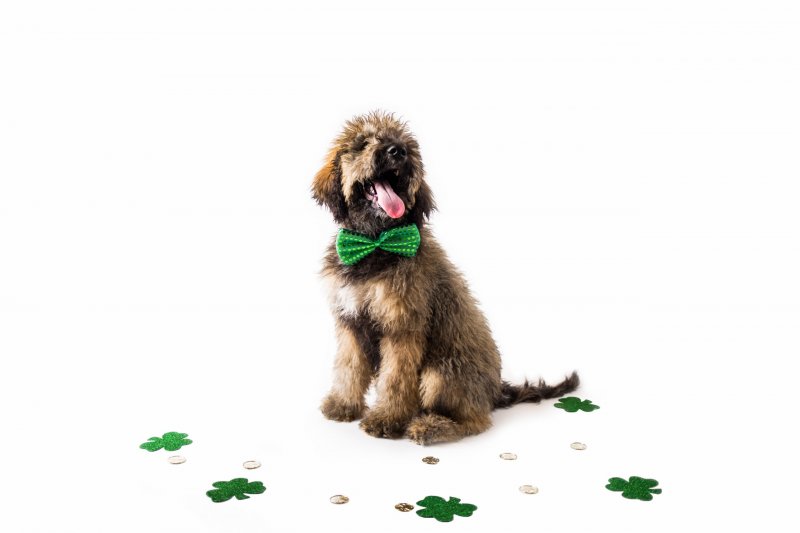
Irish Doodles have so many positive traits, it’s hard to know where to start! Towards their owners, they are affectionate, loyal, devoted pets. Compared to other breeds your friends might own, your Irish Doodle will be exceptionally friendly towards people and other animals, very eager to please, and highly intelligent.
While there is nothing threatening about this teddy bear of a dog, and Irish Doodles are not famed for barking and growling to scare away intruders, you can still count on him to do his job as a watchdog and let you know if anything is amiss on your property.
Irish Doodles inherit the Irish Setter trait of never forgetting something they have learned. This is wonderful if you teach them important manners, but can be a problem if they learn bad or destructive behavior such as opening and emptying your kitchen drawers.
The Poodle genes in your Irish Doodle make him good with children unless he ends up being overly sensitive to loud noises, and unexpected contact or action. In that case, you need to work hard to get him used to the rambunctious atmosphere of a household full of kids, teaching him to tolerate outside stimulus with patience.
If you decide to bring an Irish Doodle home, you will never have any issues with him that make you wonder what you got yourself into. If you are looking for an easy-going companion who will be happy with whatever you plan for the day’s activities, an Irish Doodle is a perfect choice.
Behavior around other dogs
Irish Doodles get along well with other pets in their homes. And if you socialize them early and often with other dogs, they will also learn to enjoy meeting fellow canines on walks or in the dog park.
Irish Doodles are very adaptable and can get along with all breeds and sizes of dogs. They have no fear of dogs that are larger than them and don’t act aggressively towards smaller ones. They don’t have anything to prove, don’t have a chip on their shoulder, and have no desire to become the alpha at the dog park. All the Irish Doodle wants is to have as much fun as he possibly can, with whoever is willing to go along for the ride.
Is an Irish Doodle a good Family Dog?
Families with children will love owning an Irish Doodle. This dog loves to play and often engages in comical behavior – thanks to their Poodle genes.
Irish Doodles rarely bark, so there is little chance of them scaring your little ones.
If left alone for too long, Irish Doodles get anxious and destructive. The Irish Setter in them makes them prone to suffering from separation anxiety, and the Poodle in them makes them get bored very easily when left alone. They are even known to run away if they think their master is gone forever. So make sure never to leave your Irish Doodle alone for too much time. Having another pet in the house, or a family member who is home most of the day is the best setup for this dog. If you are a single person who spends long hours at work, you probably shouldn’t think about getting an Irish Doodle.
Irish Doodles are very adaptable dogs and are equally happy living in apartments, houses with a yard, or on large farms.
How to Train an Irish Doodle
If you are one of those people who expect an immediate response when you utter a command, perhaps you shouldn’t own an Irish Doodle. These dogs are not always the easiest to train because of their Irish Setter genes. The Irish Setter tends to have a short attention span and responds well to dog training sessions only if treated with the utmost respect. This is a breed you need to almost court in order to get it to obey. On the other hand, the Poodle genes in an Irish Doodle can make him quite easy to train…Since you have no way of knowing which traits your Irish Doodle has inherited, training him will be an unpredictable experience. Fortunately, Irish Doodles are very easy to house train. So the hardest part about having a puppy won’t be that hard.
The only way to make any progress teaching your Irish Doodle commands is to employ the tools of continuous praise for desired behavior, gushing enthusiasm, and an endless supply of good treats. Keep in mind that you will need a lot of patience to train your Irish Doodle, but if he sees learning new tasks as fun, he will excel and anything you teach him.
How to Care For an Irish Doodle
Exercise Requirements
While the Irish Doodle is an energetic, playful dog, it doesn’t need an excessive amount of exercise. Be it walking or jogging at your side, or playing fetch in your yard or a park, Irish Doodles will happily follow your lead when it comes to getting outside and moving. This dog loves swimming and hiking and can learn to play fly ball.
Your Irish Doodle needs about one hour of scheduled exercise per day, not including the time he spends alone in the yard. The rule for exercise is five minutes per day for every month of your puppy’s age. While they are still young, and their bones are still soft, it can be dangerous to take Irish Doodle puppies on very strenuous treks. They are at risk of developing skeletal disorders if their activity isn’t monitored when they are still growing.
When out in public areas it is best to keep your Irish Doodle on a leash. Their Poodle genes give them a selective hearing, and they don’t always come when called.
Grooming and Shedding
Don’t think about cutting or trimming your Irish Doodle’s coat until he is six to nine months old. Until then, you should diligently brush his coat every day to prevent matting and knotting. If knots form in the groin area or paw pits, it can pull and cause pain when your Irish Doodle runs and jumps.
In general, Irish Doodles don’t shed very much. But if you are diligent about brushing your Irish Doodle at least twice a week, you will be able to keep his shedding down to a bare minimum.
If you decide to start clipping your Irish Doodle’s coat, he will only need to be brushed two to three times a week. But if you keep his “natural look”, never touching his fur with scissors or clippers, continue brushing him every day. In any case, it is recommended to occasionally trim the hair inside his ears to prevent the accumulation of dirt and subsequent infections.
Don’t forget to bush your Irish Doodle’s teeth! He is so attractive that you wouldn’t want his total image to be ruined by decaying teeth or a smelly mouth.
What To Feed A Irish Doodle
Irish Doodles puppies need three to four meals a day. By the time they are a year old, Irish Doodles can make do with two meals a day. Feed your Irish Doodle the most expensive, high-quality food you can afford so that all his nutritional needs are met. The first ingredient on the label should be a meat product.
This is a dog with lots of energy to burn and a hardy appetite. Your Irish Doodle isn’t a picky eater, and will gladly consume dry food, wet food, or a mix of the two. Between 2 ½ and 3 cups per day should be sufficient.
Irish Doodles are prone to obesity, so make sure not to give your pet too many treats or table scraps as he grows and ages.
Known Health Problems
While many purebred dogs have inherited health problems, the Irish Doodle tends to be a generally healthy dog because it’s a hybrid. The puppies born to two different breeds tend to be more resilient than either of their parents.
The most common health issues that can develop in Irish Doodles are those that many other dogs suffer from in their lifetimes: hip and elbow dysplasia, eye problems, and bloat. You should monitor your Irish Doodle for these conditions, and if they do develop your vet can provide treatment early on to prevent any serious disability.
Irish Doodles have a lifespan of 10 to 13 years.
Buyer’s Guide
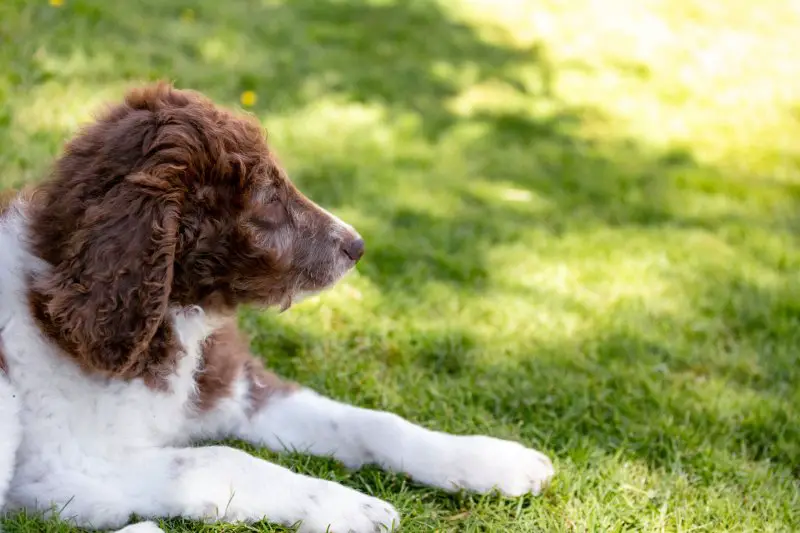
How to Choose an Irish Doodle Puppy
Choosing an Irish Doodle puppy is kind of like winning a door prize. You know you will be receiving something really good, but you have no idea of what it will be until you actually get it. Since Irish Doodles inherit desirable traits from both their Irish Setter mothers and their Poodle fathers, there is no way to know whether your pup will be a “50-50” model or one that has inherited more of the appearance, temperament, and health from one of its parents.
If both parents are Irish Doodles, or if one is an Irish Doodle and one is a Poodle, the traits of the litter will be more predictable. It’s important to ask the breeder if his puppies are F1, F2, or F1b, for example. Every classification tells you what type of dogs are parents to the puppies. The table below explains the different ways Irish Doodles are produced.
| Breeding Code | Parents | Example |
| P | Both parents of a dog are the same purebred breed | Father – Poodle Mother – Poodle |
| F1 | 50% Purebred-A 50% Purebred-B | Father – Poodle Mother – Irish Spaniel |
| F1b | 75% Purebred-A 25% Purebred-B | Father – Poodle Mother – Irish Doodle |
| F2 | 50% F1 50% F1 | Father – Irish Doodle Mother – Irish Doodle |
| F2b | 75% Purebred-A 25% Purebred-B | Parent #1 – F1 Parent #2 – F1b |
| F3 | 50% F2 50% F2 | Father – Irish Doodle Mother – Irish Doodle |
How Much Do Irish Doodles Cost?
Depending on the color of its coat, the location and reputation of the breeder, and the pedigree of its parents, an Irish Doodle can cost anywhere between $1500 to $3500 dollars in the United States. Known as a designer dog, if a popular celebrity or musician suddenly gets one of these dogs and starts posting photos of it on Instagram, you can be sure the prices will go even higher.
The Irish Doodle is so rare that there are no rescue organizations set up just for this dog. If you want to try to find an older Irish Doodle to adopt, you will have to place an ad online, or put in requests at as many nearby rescue organizations as you can. If you are lucky, maybe a pre-owned Irish Doodle will come your way. If now, purchasing a new and expensive puppy will be the only way to go.
Quick Breed Summary Table

While there are many different “Doodle” dogs (Poodles mixed with other breeds), the Irish Doodle most resembles the Goldendoodle. Many people confuse the two, so it is important to understand the differences between the two before you decide to bring an Irish Doodle home.
Both Irish Doodles and Goldendoodles are happy, upbeat dogs. Both are good with children and are very playful. Finally, both of these hybrids are very intelligent.
| Irish Doodle | Goldendoodle | |
| Parents | Irish Setter + Poodle | Golden Retriever + Poodle |
| Height | 12 – 15 inches (33 – 38 cm) | 24 – 26 inches (61 – 66 cm) |
| Weight | 40 – 70 pounds (18 – 31 kg) | 55 – 70 pounds (14 – 31 kg) |
| Colors | Red, apricot, black and brown, while some coats will have a splash of white | Golden, cream, black, red, and yellow |
| Coat | Long and wavy | Medium length and curly |
| Hypoallergenic or not? | Tends to be the more hypoallergenic of the two – the more poodle is in the dog, the more hypoallergenic it will be | Tends to be the less hypoallergenic of the two – the more poodle is in the dog, the more hypoallergenic it will be |
| The main reason for creating this hybrid | Companion dog | Service/therapy dogs (for people allergic to purebred Retrievers) |
| Training | Selective hearing, somewhat stubborn, more work to train | Very eager to please and serve, very easy to train |
| Exercise needs | A very active dog that needs at least an hour and a half of exercise per day | The average need for exercise – 45 minutes to an hour per day |
Summary
If you want a best friend who can double as a running partner during the day and a cuddle toy at night, the Irish Doodle is a good choice. This dog has a high price tag, but it also has a hard to find happy, go-lucky personality and a coat that is both attractive and rarely sheds.
The Irish Doodle is not a cheap dog to buy. If you do decide that this is the dog for you, and you are willing to spend over $1000 dollars for the pleasure, make sure the breeder gives you everything you deserve. You should be supplied with the puppy’s medical records, the puppy’s immunization records and proof he has been dewormed, and medical reports for both of the puppy’s parents.
While Irish Doodles are attractive, endearing dogs, you want to make sure the one you bring home is as healthy as he is happy when you first meet him and pick him out.
More Irish Setter and Poodle Mixes
Want an Irish Setter mix or Poodle mix but aren’t keen on the Irish Doodle? Check out these other hybrid dog breeds:



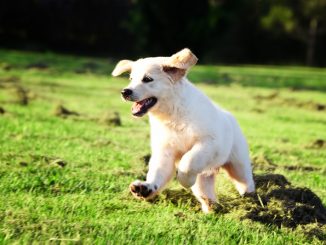

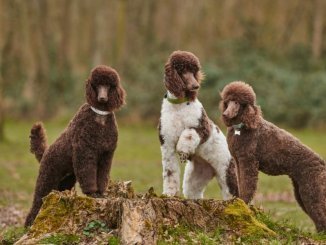


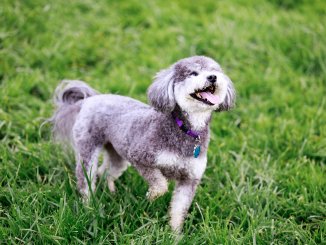

Be the first to comment